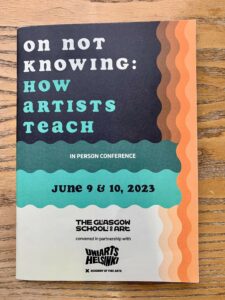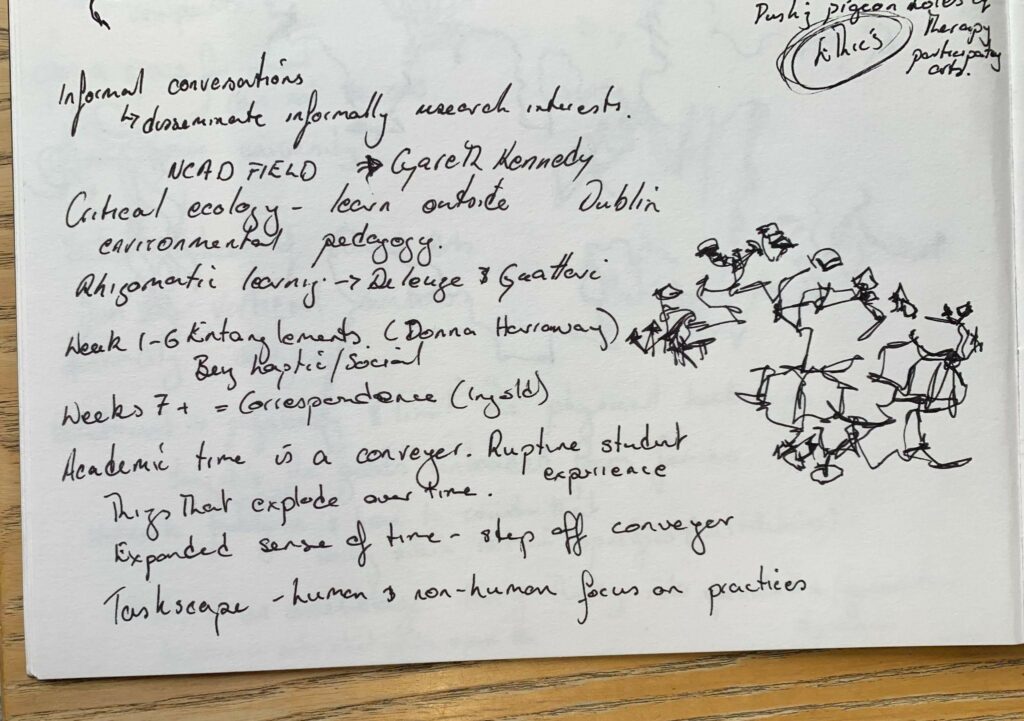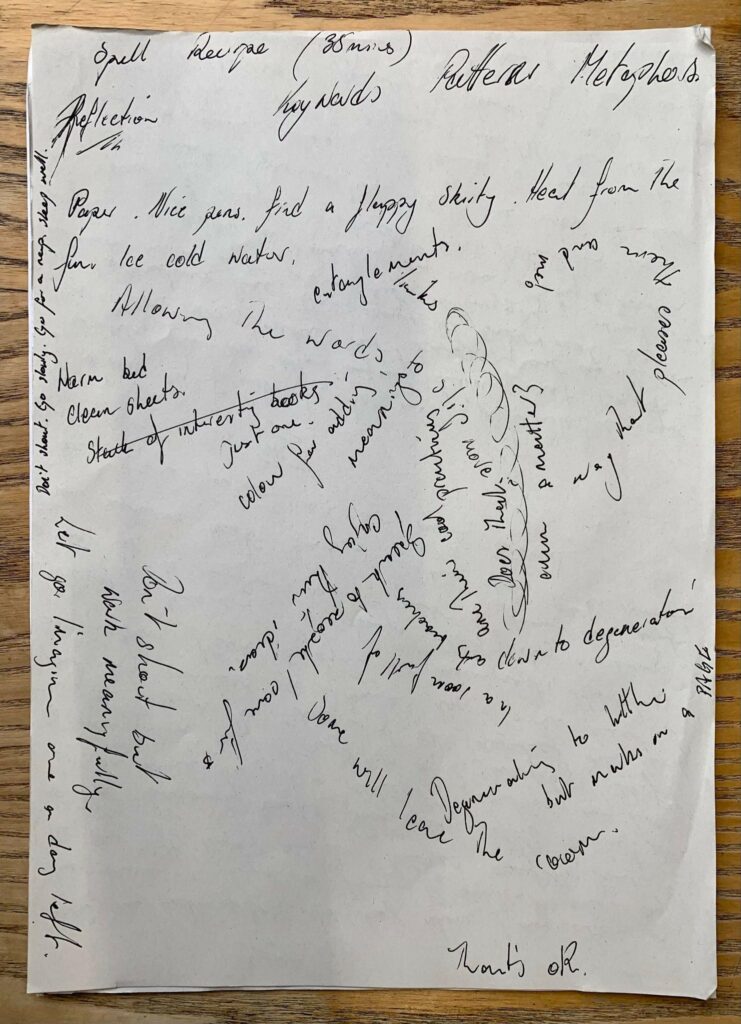By Simone Maier
In the run up to the wonderful #ALDcon24, we thought we’d share one of our colleague’s reflections on a truly empowering conference experience. Simone went to the Glasgow School of Art Teachers Conference as a learning developer, as an art teacher on an Art Foundation Programme, and as a Masters student exploring Art and the Pedagogy of Art. Here Simone reflects on that Conference and on the power of Practice Based Research as a way of surfacing our deep values and predispositions – those that cannot at first be articulated through language – where even attempting to articulate them through language can be problematic. We hope that in reading this you, like us, will be inspired by arts-based practices as powerful ways of reflecting on our own work and processes – and of working powerfully together with our students: there is power in not knowing; there is inspiration to be found in how artists teach.
Energised in the wake of the Glasgow School of Art Teachers Conference
I recently travelled with a group of staff and postgraduate students from the MA in Art Education, Culture and Practise to the ‘on not knowing: how artists teach’ conference, convened at Glasgow School of Art (GSA) and organised in partnership with the University of the Arts Helsinki. One of the key people behind the conference was GSA’s Professor, Rebecca Fortnum. Many years ago, a tutor referred me to Fortnum’s book Contemporary British Women Artists: In Their Own Words as it contains interviews that examine some of the issues that I was trying to work through as I studied towards a BA in Fine Art. I found Fortnum’s methodology – qualitative research via interviews – to provide frank and surprising insights that offered me the language (Collini 2017) to begin to frame my nascent practice-based research (PBR).
Practice Based Research
Fortnum’s research appeared again on the pre-reading list for my master’s degree – a chapter called ‘Creative Accounting’ (Fortnum 2013) in which Fortnum weaves together quotes from artists to substantiate exciting ideas about the conditions needed for artists to make. Publishing chunks from the interviews she conducted with artists struck me as a generous way to put forward new ideas – it offers up the source material – allowing me, as the reader, to conduct my own discourse analysis to incrementally decide if I agree with how Fortnum’s interpreted and utilised the interview discourse to substantiate radical ideas. I got hold of a copy of the book (now out of print and constantly on the waiting list of borrowers at UCL’s library) that the ‘Creative Accounting’ chapter was published in. On Not Knowing: How Artists Think is edited by Fortnum and Elizabeth Fisher. One of the central ideas the title asserts is that via not articulating the ideas or ambitions behind PBR, artists discover something that would have been limited by language (Fortnum 2013, 79). I had an inkling, based on my experience of trying to develop sculpture in my kitchen during the pandemic, that language could restrict and even curtail making; I’d found that the constant well-meaning questions from my family interrupted my attempts to continue practice-based research. I temporarily gave up on making, to focus on the demands of pivoting a Foundation course to online spaces and the misnomer of ‘homeschooling’ my sons. (Just thinking about that time causes me to involuntary exhale!)
During the last five years, as a tutor and module leader on a foundation art and design course, I’ve often pondered the problematic relationship between language and making. In an increasingly measurement-driven HE context, I find myself at odds with colleagues as I argue for studio spaces in which students are allowed to work through and with materials (charcoal, paint, collage, assemblage etc) rather than passively receiving contextual lectures and briefs that steer them towards outcomes – and lots of discussion! The Conference became a place to explore these ideas collegially and in freedom.
The Conference itself
I eagerly signed up to the GSA conference hoping that it would offer a rich environment to consider the activities, practices, strategies and challenges other creative LDers face and thereby inform my grappling with the potential and conflicts of language as a necessary part of art education.
The two-day conference offered three concurrent lectures and two workshop alternatives for each morning and afternoon session. Too many choices, argh! Coming with such a big group meant we could split up and share the key insights (and frustrations!) offered by different speakers and facilitators. Our social media accounts were ON FIRE with WhatsApp and Insta posts, recording our thoughts, notes, workshop making, and clips from engaging speakers. On Friday morning, I joinedthe ‘New Material Encounters – New Materials and New Materialism’ session that the convenors told us they’d selected because “their proposals left us wanting to know more”. I enjoyed Andrew Prior and David Strang’s presentation about their interactive arts collective, HOTWIRE, that used elastic bands and drone machines to experiment with making a collective machine orchestra. They argued that “There isn’t enough dissonance” in art education and for new, non-expert, bodies to enter and disrupt workshops. I wondered how I could allow for more dissonance in the foundation assemblage project.


Aubyn O’Grady from The Yukon School of Visual Arts in the sub-arctic community of Dawson City, Canada, spoke about her students’ physically connecting with the landscape and how the isolation of her institution propels her to think deeply about the ecological and social impact of art education in a very remote community in which everything enters via a single highway that is regularly cut off by climatic events. She was ANGRY about the lack of urgency HEIs are displaying towards the climate crisis.
In the afternoon, I shuffled along the row, in an overheated lecture room, to listen to a rapid series of talks under the heading ‘There is Something We Can Do: From Not-Knowing To New Theatres of Encounter and Agency within the Art School’. My highlights included:
- Artist and Royal College of Arts Senior Lecturer, Mel Brimfield, presenting a ‘talk’ as a film. It poked fun at some of the contradictions of working and studying within HE and left me questioning if I was subject or complicit in some of the unpleasant elements of HE and uncertain if I identified as the student or teacher in the movie.
- A presentation by Proximity Collective(@proximity_collective) offered a sense of hope that if I do ever embark on a PhD, it could be a joyful experience corralled by the enthusiasm and “leaks” across the practices’ of other researchers. I love the notion of research leaking!
- Royal College of Art tutor, Graham Hudson, gave a talk accompanied by a film work explaining how he uses fitness as material. He amusingly described being sacked from a job as a Personal Trainer when he disclosed that he did it to inform his sculptural practice.
- Gareth Kennedy, an assistant lecturer at the National College of Art and Design, Dublin, spoke about the possibilities for environmental pedagogy. He described how, as part of the ‘Sculpture and Expanded Practice’ course that he runs, he takes students to an abandoned plot adjacent to the campus to “rupture student’s experience” via rhizomatic learning as they forage, garden and eat off the land.
- Emma Drye, Programme Leader for painting and drawing at the Open College of the Arts, described her “light touch” pedagogy that involves “teaching via listening”. Her calm, confident and co-constructive approach left me yearning to join her online course.

The day concluded with a keynote presentation that was like no other I’d experienced. Delivered by Professor Susan Philipsz who is a Turner prize winner, sound artist, and course leader at the Academy of Fine Arts, Dresden (HfBK). In a pendulum shift from the emphatic ‘Ted Talk’ style I’d come to expect of keynote presentations, Philipsz deployed modesty. She played clips from her sound and spatial works to illustrate her proposition that we should teach by doing. She proposed that teaching art should begin with a tutor showing their own artwork as the jumping-off point to co-construct new works. Amongst excerpts from intriguing pieces she argued that “once generated, sound never dies”. The talk concluded with fragments of the radio international collective work that Philipsz and her students presented at Manifesta 14 in Prishtina, Kosovo.
In my context, teaching on a foundation course, I’m undecided if showing my work is a good idea; it risks steering students towards my interests and a ‘house-style’ rather than offering a space in which they bring their own concerns and creative practices.
Slightly weary following a night of dancing, I began Saturday in a fascinating and edgy session called ‘Feminist pedagogies into and out of the Art School’. It was thrilling to listen to a presentation by the post-institutional Felicity Allen (who I’d first come across as the editor of the lauded compilation Education: documents of contemporary art (Allen 2011)). Allen came across as really personable. She used photos and anecdotes recounting episodes in communes, writing groups and various HE setting before concluding with her exciting and hopeful concept of the Disoeuvre:

Rather than disregarding those whose conventional oeuvre seems interrupted and inconsistent, we should look for artistic consistency in an artist’s work made in and beyond the studio, through employment at art’s institutions – which may include activism for structural change, or connected, for instance, to the labour of care, activism, or other social practices.
The session continued with brief descriptions of feminist art practices of five other academics. It finished with a Q&A managed by convenor Professor Hilary Robinson during which she detailed some of the battles she has waged to bring about change in sexist institutional practices. I left the session feeling indebted to these women for their stoic efforts but also with a sense of unease. While I aplaude the session’s stated aim of coalescing “towards further cross-institutional activity”, time did not permit this to happen. The session’s contributions – all from Write-Read-Write art-writing group -spoke of “complementary spaces” but none of them indicated in their presentations an appreciation for what I encounter teaching on a foundation course: digital spaces systemically influencing students’ identity politics.
Leaning against the bike racks discussing the presentations with other tutors, it dawned on me that my sense of disquiet might be the result of a generational change. A binary approach to gender that the session’s presentations appeared to be predicated upon, is no longer relevant to me. Many of my foundation students presume an intersectional approach in which social constructs, including gender (Butler 2006), are conceived of in a more fluid manner. Legacy Russell’s 2020 book, Glitch Feminism, offered me more insights for welcoming and supporting contemporary students than I picked from this session. However, I appreciate the contributors’ energy, willingness to share their historically significant journeys and I’ll look into Allen’s notion of the ‘disoeuvre’ which strikes me as a fruitful way to conceive of the fragmented practices necessitated by late-capitalistism.
The final session I attended was ‘Writing Practices in the Art School’. Based on the contributors, I’d been told to expect it to be a really fruitful session. In the overcrowded room, a palpable sense of frustration grew before opening up in the Q&A when a few false presumptions made by some of the contributors – students don’t enjoy writing and ‘first-generation students’ needing remedial support to write academically – were unpicked. I wish we’d abandoned the guided writing activity (see image 6) to allow more time to discuss the varied experiences and strategies of the deeply invested participants and contributors who quickly transformed the session into a space for informally working through specific institutional challenges with an empathetic and knowledgeable audience. It was heartening to hear colleagues share experiences of the liberatory experience of academic writing based on their own and student exploits. And, I’d gained language that may help me to challenge the false binary of practice vs theory that persists in some art educational spaces.
On not knowing: What we can learn by how artists teach
As the conference drew to a close, I had a renewed sense of anger as a powerful and useful source of energy; the sessions’ themes split over into all the in-between places: lunch benches, hotel lobbies, and walks around the end-of-year exhibitions. In doing so, GSA provided much-needed space to unpick some of the specific pedagogical and curricular issues in conversations with other art tutors. It allowed me to glean an understanding of how other LDers balance language (e.g. crits, tutorials, presentation of briefs, critical and contextual theory) with material practices. Being with other LDers who understand what it is to make, teach and work within challenging HE educational settings felt nourishing. I left Glasgow with a renewed enthusiasm for the difference HE art education can make to the entangled lives of us all – tutors and students.

Bibliography:
Allen, F. (ed.) (2011) Education: documents of contemporary art. Whitechapel Art Gallery and MIT Press.
Butler, J. (2006) Gender Trouble: Feminism and the Subversion of Identity. Routledge.
Collini, S. (2017). Speaking of Universities. Verso.
Fortnum, R. (2006) Contemporary British Women Artists: In Their Own Words. I.B. Tauris.
Fortnum, R. (2013) ‘Creative Accounting’, in On Not Knowing: How Artists Think. London: Black Dog Publishing.
Russell, L. (2020). Glitch Feminism: A Manifesto. Verso.
About Simone Maier
Simone is an artist, researcher, and lecturer. She teaches within the School of Art, Architecture and Design at London Metropolitan University. Her creative and written practices examine the tensions of teaching in neoliberal times, with inaccurate narratives about the value of art and design education that she asserts to be both necessary and hopeful.
Her artworks often combine poetry and sculpture. Her artworks reflect on the contradictory nature of language, finding it to sometimes limit artistic exploration while also offering new ways of thinking. Recent artworks include an ongoing series of expanded drawings titled ‘Gathering’ that use quotes, watercolour, charcoal, and silk thread. The series is influenced by the students she teaches on a foundation course and the research of Sara Ahmed.
Simone holds an MA in art education; a PGCert; FHEA; two bachelor’s degrees – one in English Literature and a second in Fine Art. She is a UCU rep and serves as a National Councillor for NSEAD (the National Society of Education in Art and Design).

